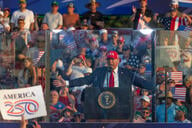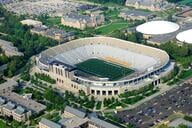You have /5 articles left.
Sign up for a free account or log in.

Scott Chandler | UCLA Athletics
About halfway through his football career at the University of California at Los Angeles, Ramogi Huma, founder of the National College Players Association, said a coach told him during an off-season meeting that he “was an NFL guy with real potential.” The coach's comment was a surprise to the undersized linebacker.
“I was going to make sure I got my degree, and I really didn’t think the NFL was much of a possibility for me,” he said. “But then it got into my head that maybe it actually was.”
With that, Huma briefly joined the 52 percent of Division I football players who believe it is likely they will play in the National Football League, according to the National Collegiate Athletic Association's own data. Then, in 1998, a hip injury ended Huma's football career and ensured that he would remain a member of a different, less hopeful cohort: the 98 percent of college football players who never go pro.
Odds are, Huma said, he likely wouldn’t have played in the NFL even if he remained healthy. “If you had to generalize, you could easily say no one goes pro,” he said. “That’s how slim the chances are.”
Yet college athletes vastly overestimate their chances of playing professional sports. The problem is so pervasive that Mark Emmert, the NCAA’s president, devoted significant space to the issue during his most recent state of the association address, saying that "athletes often have incredibly unrealistic perceptions of their professional prospects."
According to NCAA surveys, more than 60 percent of Division I college men’s ice hockey players think it’s likely they’ll play professionally, but less than 1 percent ever go on this should be plural "play," but wasn't sure - PF***that's what i think too but grammar check keeps saying "play" -jn to the National Hockey League. About 45 percent of Division I women’s basketball players think they have a chance to play professional basketball, but only 0.9 percent of players are drafted by a Women’s National Basketball Association team. (The NCAA said that it is currently procuring data on a player’s chances of joining other professional leagues, such as those in Europe, but the information is not yet available.)
Men's hoops players are the most unrealistic. More than three-quarters of men’s basketball players in Division I say they believe it is at least “somewhat likely” they will play professionally. More than half of Division II players say the same, as do 21 percent of Division III players. Only 1.2 percent of college basketball players will be drafted by a National Basketball Association team.
Some college programs feed those hopes by prominently advertising their connections to professional sports when recruiting athletes. Michigan State University entices basketball recruits with a running list of all the NBA players who first played under its successful basketball coach Tom Izzo. On its recruiting website, UCLA is described as “#1 in Olympic Gold Medals from 1984 to 2008" and “#1 in professional athletes.”
A UCLA spokesman said for athletes who do dream of going professional, the information can be helpful when choosing a program. After all, some music schools prominently display their alumni who have won Grammy and Tony awards.
Going Pro: Division I Perceptions and Reality
Men's basketball
Perception: 76 percent
Reality: 1.2 percent
Women's basketball
Perception: 44 percent
Reality: 1.9 percent
Football
Perception: 52 percent
Reality: 1.6 percent
Baseball
Perception: 60 percent
Reality: 9.4 percent
Men's ice hockey
Perception: 63 percent
Reality: 0.8 percent
Men's soccer
Perception: 46 percent
Reality: 1.9 percent
For many athletes, the idea they will one day play at the professional level is a seed that is planted long before they’re even approached by colleges, said Gershon Tenenbaum, a sports psychology professor at Florida State University.
It’s a “self-bias phenomenon,” Tenenbaum said, exacerbated by the level of adulation that surrounds successful athletes. Some athletes, he said, may be well aware of the NCAA’s research, but “this does not alter their belief, because they’re thinking, ‘I am not a statistic.’”
By the time athletes reach college sports, they’re standing near the top of an athletic pyramid. For years, they’ve moved on to higher and higher levels of competition, eventually advancing farther than as much as 97 percent of their peers. Just over 3 percent of high school men’s and women’s basketball players make it to the NCAA. About 6 percent of high school football players go on to play for a college team.
That success is often accompanied by high praise and higher expectations.
“It’s the nature of how elevated sports are in this country, even at the youth level,” said Dan Lebowitz, the executive director of Northeastern University’s Center for the Study of Sport in Society. “By the time a basketball or football player gets to Division I or Division II, they’ve already been a star in their own town and community. They have been elevated to celebrity status at such a young age, before their frontal lobe has even fully developed. It creates a high confidence level, but also a delusion around what’s actually possible.”
And when athletes think of college sports as nothing more than auditions for professional leagues, Lebowitz said, they're less likely to focus on studying or earning a degree.
This is particularly true for college athletes coming from low-income communities and locations where athletics is seen by some talented players as one of the few viable routes to a better life, said Mark Nagel, a professor of sports and entertainment management at the University of South Carolina.
“Good athletes get so consumed with playing their sports, it’s very difficult to take a step back and realize what else is going on,” Nagel said. “It’s commendable in some ways, because it’s really what they want to do. It’s an all-consuming passion.”
Explaining to athletes that their passion -- and years of hard work -- is not likely to lead to a career is an uncomfortable but necessary conversation to have, Emmert said during his address at the NCAA's annual meeting earlier this month. “How can we help them understand the realities of what that looks like?” he asked. “What can we change to give them a more realistic sense of it? How do we get a handle on that? How can we provide them with a greater sense of the realities and what that looks like?”
An NCAA television ad and poster campaign does advertise that “there are 400,000 NCAA student-athletes, and almost all of them will go pro in something other than sports,” though athletes don't always absorb the message.
During this year's NCAA Convention, several college athletes argued that coaches should be allowed to eliminate an athlete's scholarship for reasons based on his or her athletic performance. “College sports prepare you for professional sports,” one college baseball player said, adding later that “people forget that our job is to perform.”
Most athletic departments at least provide athletes with the NCAA's research, Nagel said, but that doesn’t mean the numbers stick.
“How passionately they explain the numbers and how much they emphasize the deck is stacked against athletes varies between institutions,” he said. “It is a message that a lot of coaches don’t want to send. And it’s a message, frankly, that a lot of athletes don’t want to hear at this stage in their lives.”




